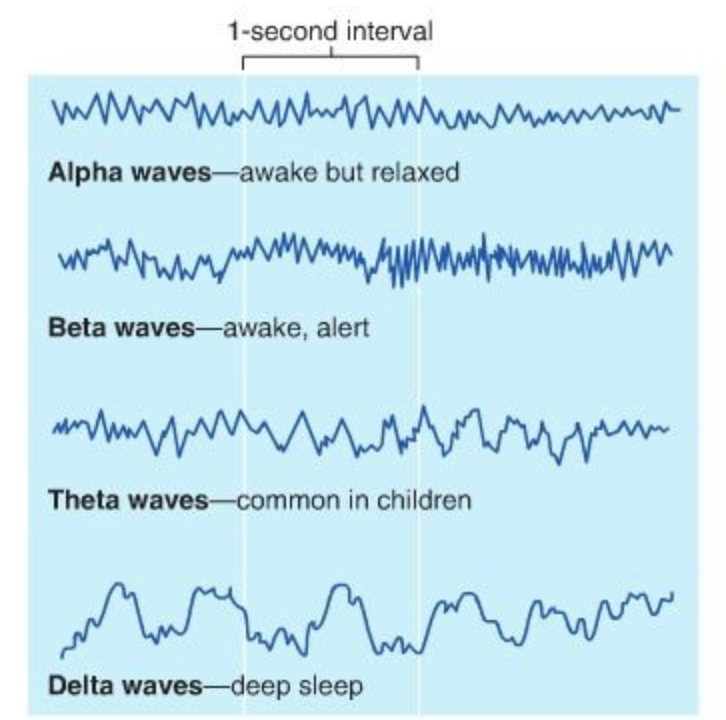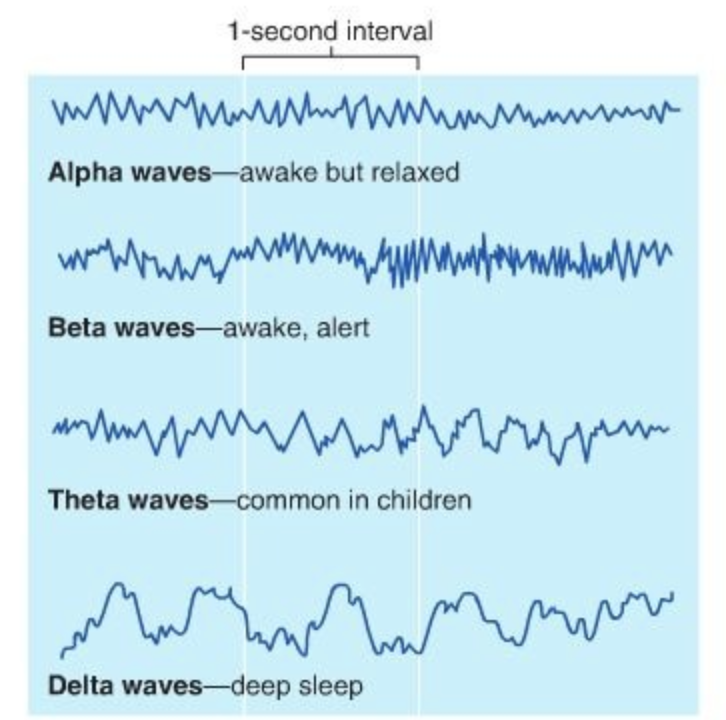AP Psych. Unit 2 Biological Bases of Behavior (Part 2: sleep, consciousness, and sensation)
1/94
There's no tags or description
Looks like no tags are added yet.
Name | Mastery | Learn | Test | Matching | Spaced |
|---|
No study sessions yet.
95 Terms
sensation
process by which our sensory receptors and nervous system receive and interpret stimulus energies from our environment
sensory receptors
sensory nerve endings that respond to stimuli
perception
process of organizing and interpreting sensory information, enabling us to recognize meaningful objects and events
bottom-up processing
analysis that begins with the sensory receptors and works up to the higher levels of mental processing
top-down processing
information processing guided by higher-level mental processes, as when we construct perceptions drawing on our experience and expectations
transduction
the process of converting one form of energy into another form of energy that your brain can use (recieve, transform, deliver)
psychophysics
studies the relationship between physical energy we can detect and its effects on our psychological experiences
Gustav Fechner
early German psychologist credited with founding psychophysics
absolute threshold
the minimum stimulation needed to detect a particular stimulus 50% of the time
signal detection theory
predicts how and when we detect a faint stimulus (signal) amid background stimulation (noise)
subliminal
signals you can’t detect 50% of the time; below your absolute threshold
priming
unconsciously activating certain associations, predisposing our perceptions, memory, or response
difference threshold (just-noticeable difference)
the minimum difference between two stimuli required for detection 50% of the time
Ernst Weber
identified just-noticeable-difference (JND) that eventually becomes Weber’s law
Weber’s law
principle that, to be perceived as different, two stimuli must differ by a constant minimum threshold as just noticeable difference
sensory adaptation
decreased receptor firing as a consequence of constant stimulation
habituation
decreased mental response to a stimulus after frequent repeated exposure
wavelength
distance from one wave peak to the next
hue
the color we experience
intensity
the amount of energy in light waves (determined by waves height/amplitude)
cornea
the transparent, dome-shaped front layer of the eye that covers the iris and pupil
pupil
a small adjustable opening
iris
the colored muscle in your eye that dilates or constricts depending on light intensity
lens
focuses the incoming light into an image on the retina
retina
a multilayered tissue on the eye’s sensitive inner surface
accommodation
lens changes shape to focus on near or far objects
photoreceptor cells
rods and cones
rods
detect black, white & gray; necessary for peripheral and twilight vision
cones
detect fine details and color sensation; cluster in and around the fovea (color, clarity, center)
optic nerve
the nerve that carries neural impluses to your brain
blind spot
the spot where your optic nerve meets your retina and you have no receptor cells
fovea
the central focal point in the retina, around which the eye’s cones cluster
young-hemholtz trichromatic (three color)
theory that the retina contains three different color receptors- one most sensitive to red, one to green, and one to blue; when stimulated in combination can produce the perception of any color
dichromatism
people that can’t see either red/green shades or blue/yellow shades
monochromatism
people that can only see shades of gray
opponent-process theory
the theory that opposing retinal processes(red-green, yellow-blue, white-black) enable color vision
David Hubel
sensation and perception - discovered feature detectors
Torsten Wiesel
David Hubels partner; discovered feature detectors in the visual system
feature detectors
specialized neurons in the occipital lobe that respond to specific features of stimuli such as shape, angle, or movement
parallel processing
the brain’s ability to simultaneously process multiple pieces of information or stimuli
audition
hearing; the sense of sound perception
loudness
a sound’s intensity determined by the amplitude of sound waves
frequency
determines the pitch
pitch
a tone’s experienced highness or lowness; depends on frequency
middle ear
three tiny bones called ossicles (hammer, anvil, stirrup)
cochlea
a snail shaped tube in the inner ear
inner ear
the innermost part of the ear, containing the cochlea, semicircular canals, and vestibular sacs
sensorineural deafness (nerve deafness)
damage to cochlea’s hair cell receptors
conduction deafness
damage to mechanical system that conducts sound waves to the cochlea
cochlear implant
converts sounds to electrical signals and stimulates the auditory nerve
place theory
hair cells in the cochlea respond to different frequencies of sound based on where they’re located in the cochlea
frequency theory
the rate of nerve impulses traveling up the auditory nerve matches the frequency of a tone, enabling us to sense its pitch
sound localization
two ears (as opposed to one) help us locate sources of sound
gate-control theory
spinal cord contains a neurological “gate” that blocks pain signals or allows them to pass on the brain
gustation
our sense of taste
umami
a savory, meaty taste (Ex. tomatoes, seaweed, cheeses, ham)
oleogustus
the unique taste of fat (prominent in foods that are rancid or stale)
supertasters
have taste buds that are packed closer together, causing them to experience flavors with more intensity
nontasters
having the fewest taste buds (farthest apart taste buds)
medium taster
average number of taste buds
olfaction
sense of smell
kinesthetic sense
gives feedback on overall orientation of specific body parts; receptors in muscles and joints send information to our brains about our limbs (how we know where our limbs are)
vestibular sense
tells us how our body is oriented in space, 3 semicircular canals in inner ear give the brain feedback on orientation (balance)
sensory interaction
the principle that one sense may influence another as when the smell of food influences taste (Ex. visual cues help us to know what we are hearing)
embodies cognition
the influences of bodily sensations, gestures, and other states on cognitive preferences and judgements (Ex. when someone is holding a warm drink rather than cold, people are more likely to rate someone more warmly)
consciousness
our awareness of ourselves and our environment
cognitive neuroscience
the interdisciplinary study of the brain activity linked with cognition (including perception, thinking, memory,and language)
dual processing
the principle that information is often simultaneously processed on separate conscious and non-conscious tracks
parallel processing
processing multiple aspects of a stimulus or problem simultaneously (unconsciously)
sleep
periodic loss of consciousness in order to physically and psychologically repair and restore the brain and body
wakefulness (wave types)
awake and alert = beta waves
awake, relaxed, ready to fall asleep = alpha waves
circadian rhythm
the biological block, regular bodily rhythms that occur on a 24-hour cycle
circadian rhythm hormone
melatonin
what tool is used to measure brain waves and sleep
EEG
type of brain wave for NREM-1
alpha

type of brain wave for NREM-2
theta

type of brainwave for NREM-3
delta

NREM stage 1
lightest level of sleep, 10 mins long, pulse slows, muscles relax, may hallucinate (hyponogogic sensation)
hyponogogic sensations
vivid sensations like muscle twitches or the feeling of falling during the transition between sleep and wakefulness
NREM stage 2
20 mins long, transition to theta waves, sleep spindles
NREM stage 3
deepest level of sleep, 30 mins long, sleepwalking/sleeptalking/bed-wetting, important for well being, produce growth hormones
REM sleep
rapid eye movement sleep, irregular pulse/heart rate, may twitch, large muscles are paralyzed, vivid dreams, paradoxical sleep
REM rebound
the tendency for REM sleep to increase following REM sleep deprivation
why is REM sleep considered paradoxical sleep?
because you have the same brain waves as when you are awake (beta), eyes are also moving
jet lag and shift work
jet lag: fatigue and disorientation after traveling across multiple time zones
shift work: work schedule that involves hours outside the typical 9-5 (early morning, night shifts, etc)
memory consolidation theory
sleep plays a crucial role in the process of converting short term memories to long term memories by strengthening neural connections
restoration theory
sleep is necessary for the body and mind to restore and recover from daily activities
effects of sleep deprivation
memory fog, poor focus, slow reaction time, weakened immune system, anxiety, mood swings, depression risk
insomnia
reoccurring problems of falling asleep or staying asleep
causes: stress/anxiety, depression, drug/alcohol abuse, irregular sleep schedule
narcolepsy
uncontrollable sleep attacks, sufferer may lapse directly into REM at inopportune times
causes: stress/anxiety, depression, drug/alcohol abuse, irregular sleep schedule
sleep apnea
temporary cessations of breathing during sleep and repeated awakening (sleep without breath)
causes: enlarged tonsils, obesity, recurring infection
somnambulism (sleep walking/talking)
sleep walking or talking during NREM-3 sleep, often not recalled, affects mostly children
causes: heredity, stress/anxiety, sleep deprivation
REM sleep behavior disorder
muscle paralysis fails, brain is sleeping yet person may talk or yell, make large/aggressive movements (punching, kicking, etc)
activation synthesis theory - J. Allan Hobson
proposes that dreams result from the brain’s attempt to make sense of random neural activity (by making into a coherent narrative)
consolidation theory
proposes that sleep plays a crucial role in strengthening memories by moving them from short term to long term storage